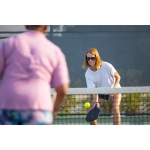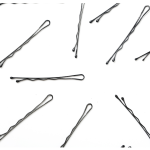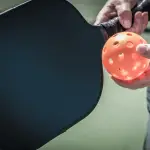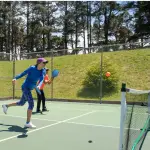When I first started playing Pickleball, I watched videos of advanced players to understand what I needed to do to improve my game. I spent quite a bit of time comparing videos of 3.5, 4.0, 4.5 and pro players to understand how the game differed at each skill level. Like most sports, there are many differences that separate players of different ratings. Sometimes these are physical attributes like quickness and speed. Other characteristics are more specific to the game like serving, serve returns, strategy, etc. Below is a summary of how you get good at Pickleball.
Serving
As your skill level improves in Pickleball, your serve should become more consistent. If you watch pro players they rarely hit a serve out since you only get one chance to put the ball in play. The serve in Pickleball is not the weapon it is in other sports like tennis so hitting 100% of serves in is the goal. With that being said, you can score points off of serves in lower levels as many players cannot deal with spin or moving quickly to a hard hit serve. Still, it’s rare to ace players even at lower levels.
Besides consistency, your goal with serving is to hit the play in the location you desire. If you find an opponent has a weak backhand then you should place the serve toward the backhand side. The other objective as you gain experience is to hit the ball as deep as possible in the court. Serves that land on or near the baseline can result in the returner not getting all of the way to the non-volley line.
Serve Return
The serve return is a lot like the serve in that it is critical to hit in the court especially as your skill level improves. At higher levels you want to hit the ball deep in the court down the middle. 50-50 balls between you and your partner can still cause confusion even for very skilled players. Another good strategy in competitive matches is to return the serve to the weaker opponent in hopes they will hit the ball out or in the net. At lower levels of play, the key is to hit the return in bounds as it is still hard to hit a winner unless hitting a short angle or drop shot that can be difficult for players who lack quickness.
Can better equipment really improve your game? Absolutely! If you start with a beginning Pickleball set you will often get wooden paddles. There is no doubt that paddles made of a composite core with carbon fiber or fiberglass surface will give you more power and control. As you improve you will find some paddles are a better fit with your game. For example, you may hit shots with spin so choosing a paddle that allows you to hit a great deal of spin improves your game. Check out our Ultimate Guide to the Best Paddles here if you are interested in seeing improvement through your paddle choice. If you are looking to buy a paddle, Amazon usually has the best selection and price.
Rules
When I first learned to play Pickleball, a friend told me the rules. 1) You can only score points when you serve. 2) Don’t go in the kitchen when returning a volley 3) If you are the serving team, the ball must bounce on the third shot before you can hit it. 4) The serve must be hit underhand in the air rather than bouncing first
Of course, he was trying to keep things simple as it was my first time playing but as you move up in skill level you learn a lot more about the tournament rules which is what most people use even in recreational Pickleball. For example, when serving not only must the serve be underhand but the head of the paddle must be below the server’s wrist at the point when contact is made.
Other interesting rules you may learn as your skill level improves and you play with more experienced players has to do with line calls and the kitchen (or rather the non-volley zone). Most people who play Pickleball, make line calls like we see in tennis. If any part of the ball lands on the line then the ball is in even if most of the ball is out. In Pickleball, this is not the case. If the ball lands on the baseline or sideline but does not touch the court (the area inside the baseline) then it is out. Here is a picture to help illustrate the rule.

Another example of rules learned as you gain more experience is that you can actually go into the kitchen. You just cannot hit a volley if you are standing in that area, hence the true name of the kitchen is the non-volley zone.
Partner

Improving in Pickleball also means you start to play better with your partners through communication and coordinated movement. Discussing who will take shots down the middle before a game, is a simple tactic but will help improve your game. Moving to the net together and back toward the baseline if put on defense by your opponent are skills of intermediate and advanced players. More skilled players also work with their partner to cover lobs hit over your head. If playing on the forehand side with both right-handed players, it may be easier for the person on the left side of the court to cover a lob on the right side of the court especially if the ball needs to be hit with your backhand.
Check out this video for an excellent example of how advanced players work as a team in their court coverage.
Technique
The most common shots beginners hit in Pickleball are ground strokes and the volley. Most serve returns require a ground stroke to be hit to get the ball back over the net. As players advance, the should be moving toward the kitchen to hit volleys near the net (but outside of the kitchen). By the time a player gets to the 3.0 level they should definitely be comfortable hitting volleys.
Overheads can certainly be hit by beginners and there is usually ample opportunity because ground strokes and volleys are usually hit higher over the net when compared to more skilled players. With that being said, overheads can also be missed by players if the ball is over their head but still lands inside the court.
Dinks, drop shots, lobs, and blocking hard hit shots usually is seen in more advanced players. Dinks are a skill very specific to Pickleball as it is not a shot you see in tennis and rarely in racquetball. The mastery of dinking begins to separate the beginning or novice player from the intermediate. This skill is critical once you get to the 4.0 level. You need to be able to sustain a dink rally and then take advantage of a higher ball to attack and be offensive. At lower levels you can win a dink rally based on consistency but as you improve, you need to take the offensive opportunities and try to attack with the goal of ending the rally because your opponent cannot return the ball. Keeping the ball as low as possible over the net and trying to hit angles which create openings are key to dinking.
The third shot drop is a unique aspect of Pickleball. It literally is the third shot after the serve and serve return. The reason to hit the shot is to have an opportunity to move just beyond the line separating the kitchen from the rest of the court. A good third shot drop will land in the kitchen and to be close enough to the net so your opponent cannot volley. The third-shot drop is a great neutralizer so your opponents cannot be offensive. For many, this is the hardest shot to master in Pickleball and least intuitive for tennis players. It’s another shot beginners rarely hit (at least not on purpose) and even many intermediate players never hit this shot, instead preferring to drive the ball at the net players. As you improve in the game, this shot should become a staple that you can hit consistently. Advanced players will usually direct this shot to the weaker side of an opponent to make the return of it difficult.
Lobs can be effective as you improve your play but should be limited. One 5.0 instructor who discussed lobs with me at a clinic said you should only lob about one-time per game. She didn’t mention at what level this should be the goal as a good lob can score many points against lower level players who do not move well. It’s much harder to hit a lob winner as you play against people of higher skills levels as they can read this shot and move quickly to the ball. Unless you hit lobs with great precision, meaning over a player’s head and deep in the court, it’s hard for this shot to be effective if hit frequently. However, it can be very effective if your opponent is caught leaning forward or returns a drop shot in the kitchen.
Blocking is a skill used to return a hard-hit ball either in the form of an overhead, ground stork, or volley. Many people learning the game of Pickleball struggle with players who hit the ball hard when they are standing just outside the kitchen. As your skill level improves, you will regularly block the ball back to your opponent after a hard hit ball to reset the point. Blocking is not an offensive shot but a chance to get yourself back into the rally. It requires anticipation of where your opponents is going to hit the ball which often comes with experience. Advanced players often will block back many shots during a rally in extended points.
Power

Water Sea Bolt Electricity Ship Ocean Lightning
Blocking is a great example of a soft shot as the ball should bounce in the kitchen. Other soft shots include dinks and drop shots. As your skill level improves, you should become more consistent in hitting these shots
More skilled players should be very comfortable with different speeds of shots in the game. They can go from the softness of a multi-shot dink rally to all of a sudden attacking with a powerful volley or overhead when at the kitchen line. Both the hard and soft shots can be challenging when you first start to play. At intermediate levels, many former tennis players are all about the power part of Pickleball hitting ground strokes, overheads, and volleys with a lot of pace. However, they are likely to neglect the softer side of Pickleball including dinks and drop shots. The most advanced players are comfortable with power and soft shots, making few errors when hitting either type.
Strategy

Beginners in Pickleball don’t use much strategy as they are just trying to keep the ball in play. As your skills develop, you become more strategic in your shot placement. Hitting down the middle on serve returns and volleys can cause confusion between even experienced players especially if playing without a regular partner. Most players’ backhands are also weaker to shots hit to that side can be advantageous and with increasing skill you can execute on that strategy. Hitting more balls to the weaker opponent is a strategy especially seen in the highest levels of play if there is a significant difference between the skill level of a team. When taking an offensive shot, it’s a good strategy to place the ball at the feet of your opponent. This strategy creates weak returns and can sometimes result in a winner to end the point.
Poaching is a strategy where your partner moves from his or her side of the court to your side in order to hit the ball to try to end the rally. This is a common strategy used in tennis at even intermediate levels but it happens less frequently in Pickleball even though it can be effective. Another advanced strategy in Pickleball is to use stacking. This technique involves a team maximizing the effectiveness of their court positioning by letting each player stand on the side where they are most effective. Stacking is used on the serve and serve return and is a common strategy among pro teams.
Patience is also an important strategy and one lacking at beginning levels of play. When you first learn about Pickleball, most players want to end the point as soon as possible by hitting a winner. This results in a lot of errors as beginners are not consistent enough to end rallies with low-percentage shots. Patience is an important strategy and will often win point at intermediate levels. In other words, hitting high-percentage shots and letting your opponent make errors can be effective. At advanced levels patience is important but needs to be combined with an offensive attacking style to end points when given the opportunity.
Movement
One of the reasons older people (myself included) like Pickleball is because it requires less movement than other sports like tennis or racquetball especially if you are playing doubles. However, this doesn’t mean there isn’t a lot of movement especially at higher levels. Beginning players first want to make sure they are moving safely. So, having court shoes rather than running shoes is critical to staying injury free as the knobs of jogging shoes can catch on the floor and cause a fall. You should also remember to stay on your feet. I remember one player new to Pickleball would dive on the court trying to get to balls. I think he may have played volleyball in his youth and while this is a necessary skill in that sport, it has few benefits in Pickleball because it puts you out of position for the next shot.
The key to movement in Pickleball is having good footwork. Beginners looking to improve in Pickleball should quickly move to the kitchen line after returning a serve or hitting the third shot. While everyone is different in terms of their speed, a good strategy to use if you are not particularly fast is to return the ball higher over the net and deep in the court. Because the ball is in the air longer due to the height of the return, it gives you more time to move to the kitchen line. I often use this technique if someone serves deep in the court to give myself plenty of time to move forward into the correct position. Another tip for improving movement is to stay away from cross-over steps when at the kitchen line. The cross over step is common in many sports but becomes the Pickleball game can move very fast, there is not enough time to recover after using a cross over when playing better opponents. Instead use a sidestep shuffle to cover the court in fast-moving rallies.
One of the skills that improves as you gain experience playing Pickleball is anticipation. If you watch the pros, you think how incredibly fast they are. While some of this is a physical attribute, they also look super quick in getting to balls because they have learned to anticipate where their opponent is going to hit the ball. Since it is hard to disguise shots in Pickleball, good anticipation is mostly the result of watching your opponent. First, check the angle of their racquet but also watch their eyes and body position. The more you play in Pickleball, the better your anticipation will become and the quicker you will seem.
Warming Up
You can learn a great deal about your opponent when they warm up. While beginners are happy to bat the ball back and forth and get it in the court, more advanced players will watch their opponents critically during warm up. First, notice which hand they play with. Beginning and even some intermediate players can go a whole game without noticing their opponent is left-handed. When warming up also see whether you opponent moves up to the net or stays at the baseline. If they stay at the baseline, your goal is to get them to move forward during the game to get them out of their comfort zone. This means hitting drop shots and short balls to get the baseliners to move forward.
During the warm up observe the shots hit at the net. Most beginners will volley but do they also know how to dink? How high do they hit the ball over the net? Do they use spin? You really can learn a lot about your opponent during a warm up even if it is for five minutes. Advanced players take advantage of this knowledge to maximize their edge.
Summary
While there are many ways to improve in Pickleball, you will advance fastest if you do these six things:
- Move up to the kitchen line. Many beginners stay in the back of the court rather than moving forward.
- Reduce your errors. You will win many games at lower levels just because you are more consistent than your opponent. Start with a goal of hitting every serve and serve return in.
- Use the third-shot drop. This levels the game and puts most of the action near the net.
- Learn to dink consistently. This is a must have shot at higher levels that many beginners are hesitant to use.
- Work to hit the ball lower over the net but still without making errors. Beginners tend to hit the ball way over the net while pros are clearing it by a couple of inches whether dinking, volleying or hitting ground strokes.
- Spend time practicing rather than playing matches. If you practice for 30 minutes, you will accomplish more than if you spent the same 30 minutes playing games.
While this article describes how different parts of the Pickleball game varies at different skills levels, you can review the skills at each rating level summarized by Bend Pickleball Club. Rating levels are used in tournament play and usually are categorized as follows: beginner (2.5 or lower), intermediate (3.0-3.5), advanced (4.0-4.5), pro (5.0).
If you need more information on how to improve your game, check out How to Play Pickleball: The Complete Guide from A to Z: Illustrated Stroke Techniques and Winning Strategies on Amazon









